History
 We have come to expect apartment buildings to look pretty much the same. There might be a few structural differences, but basically the idea is small homes stacked on top of each other, so that multiple families can be housed is a relatively small space. These days I have seen more buildings that look almost like very large houses, mansions even, but the reality is that they buildings house many families, and the apartments are rather cookie-cutter and plain.
We have come to expect apartment buildings to look pretty much the same. There might be a few structural differences, but basically the idea is small homes stacked on top of each other, so that multiple families can be housed is a relatively small space. These days I have seen more buildings that look almost like very large houses, mansions even, but the reality is that they buildings house many families, and the apartments are rather cookie-cutter and plain.
One building…the Waldspirale, which means forest spiral in English, is not just another random residential building. Designed by Friedensreich 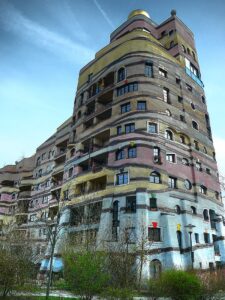 Hundertwasser, this architectural wonder located in Darmstadt in Germany. Construction began at the end of 1990s and was completed in 2000. This building is no ordinary structure. The U-shape of the building is characterized by unique multicolored facade and lack of straight lines. The plan was to make sure that no other building looked quite like this one. The inside of the building is just as unique as the outside. The inner wall corners are rounded to match the outer walls of the building. The building has 105 apartments, a garage, and a playground for children…with a tiny artificial lake…much more than the average apartment building in the 90s. The building is really irregularly shaped, and while it seems short, the highest point of the building goes up to the 12th floor. That is all interesting, but what I find the most interesting is that not one of the 1000 windows in the building are the same and the handles on the doors are also different. Imagine just finding 1000 different windows and probably as many different doors too.
Hundertwasser, this architectural wonder located in Darmstadt in Germany. Construction began at the end of 1990s and was completed in 2000. This building is no ordinary structure. The U-shape of the building is characterized by unique multicolored facade and lack of straight lines. The plan was to make sure that no other building looked quite like this one. The inside of the building is just as unique as the outside. The inner wall corners are rounded to match the outer walls of the building. The building has 105 apartments, a garage, and a playground for children…with a tiny artificial lake…much more than the average apartment building in the 90s. The building is really irregularly shaped, and while it seems short, the highest point of the building goes up to the 12th floor. That is all interesting, but what I find the most interesting is that not one of the 1000 windows in the building are the same and the handles on the doors are also different. Imagine just finding 1000 different windows and probably as many different doors too.
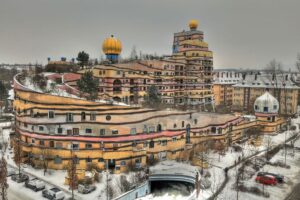 While it was designed by Austrian artist Friedensreich Hundertwasser, it was planned and implemented by architect Heinz M Springmann and constructed by the Bauverein Darmstadt company. I’m sure the uniqueness of the building, while somewhat simple to design, would take a lot of planning and the structure would take some special planning to make it stable enough to carry out the structure as it was designed the uniqueness of the plan. Since I, like many other people have watched the DIY channels, I know that the more unique the structure the more work goes into making it stable. While some people might consider it weird to live in such a building, I think it might be kind of fun.
While it was designed by Austrian artist Friedensreich Hundertwasser, it was planned and implemented by architect Heinz M Springmann and constructed by the Bauverein Darmstadt company. I’m sure the uniqueness of the building, while somewhat simple to design, would take a lot of planning and the structure would take some special planning to make it stable enough to carry out the structure as it was designed the uniqueness of the plan. Since I, like many other people have watched the DIY channels, I know that the more unique the structure the more work goes into making it stable. While some people might consider it weird to live in such a building, I think it might be kind of fun.

 Is it art or is it an exercise machine? I suppose it depends on your perspective. The strange staircase that doubles as a beautiful piece of art is located in the courtyard of an office building in Munich, hidden from public view for the most part. At first glance, it looks like a spiral staircase that is…just a little bit odd looking…like it’s a double staircase. Then a staircase seemingly leads you up…to nowhere, aaround and back to the bottom again. “Umschreibung” is not really a staircase at all. It’s actually an ominous sculpture by Danish artist Olafur Eliasson. “Umschreibung” is a German word which means “euphemism,” or “circumlocution,” the second of these made sense to me because the structure is repetitive, but the first definition didn’t, because an alternative just didn’t fit. The “Umschreibung” web site translates it to “circumscription” or “periphrasis,” meaning “a movement without destination, a space defined by motion rather than walls.” That idea is interesting and much like exercise equipment, because that is what a treadmill or exercise bike does.
Is it art or is it an exercise machine? I suppose it depends on your perspective. The strange staircase that doubles as a beautiful piece of art is located in the courtyard of an office building in Munich, hidden from public view for the most part. At first glance, it looks like a spiral staircase that is…just a little bit odd looking…like it’s a double staircase. Then a staircase seemingly leads you up…to nowhere, aaround and back to the bottom again. “Umschreibung” is not really a staircase at all. It’s actually an ominous sculpture by Danish artist Olafur Eliasson. “Umschreibung” is a German word which means “euphemism,” or “circumlocution,” the second of these made sense to me because the structure is repetitive, but the first definition didn’t, because an alternative just didn’t fit. The “Umschreibung” web site translates it to “circumscription” or “periphrasis,” meaning “a movement without destination, a space defined by motion rather than walls.” That idea is interesting and much like exercise equipment, because that is what a treadmill or exercise bike does.
The 30-foot-tall sculpture is made of steel. Basically, it is a staircase in the shape of a double helix. At the bottom of the staircase there is a small opening. It’s just the right size for an entrance, so you can actually climb the stairs yourself. I don’t know if that is allowed now or not, but it looks like it was once or is 
 sometimes. The view I saw of it has a small chain on each side of the entrance as a way of closure. If it is not allowed, I think it is a really sad thing. A staircase is meant to be climbed. The “Endless Staircase” is, as I said, located in the courtyard of an office building, and I suppose that the people who work in those offices would eventually get used to the beautiful structure just outside the window, but for me, I think I might have trouble with my imagination…especially if I was allowed to climb it once. I would want to climb it every day, maybe several times a day. There is just something about the idea of climbing a stairway that doesn’t end.
sometimes. The view I saw of it has a small chain on each side of the entrance as a way of closure. If it is not allowed, I think it is a really sad thing. A staircase is meant to be climbed. The “Endless Staircase” is, as I said, located in the courtyard of an office building, and I suppose that the people who work in those offices would eventually get used to the beautiful structure just outside the window, but for me, I think I might have trouble with my imagination…especially if I was allowed to climb it once. I would want to climb it every day, maybe several times a day. There is just something about the idea of climbing a stairway that doesn’t end.
The structure was designed and built by a man named Olafur Eliasson, who is an Icelandic–Danish artist known for sculptured and large-scale installation art employing elemental materials such as light, water, and air temperature to enhance the viewer’s experience. He was born in Copenhagen on February 5, 1967, to Elías Hjörleifsson and Ingibjörg Olafsdottir. After his parents divorced when he was 8, he lived with his mother and his stepfather, a stockbroker. His father, who was by then an artist, moved back to Iceland, where their family 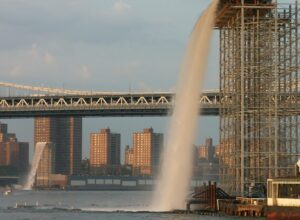
 spent summers and holidays. Taking after his father, Olafur had his first solo show at 15, exhibiting landscape drawings and gouaches at a small alternative gallery in Denmark. From there, his work grew and expanded into abstracts, which is where his fame came from. The “Umschreibung” was designed and built in 2004. Another of his cool structures is the New York City Waterfalls, and there are many others too.
spent summers and holidays. Taking after his father, Olafur had his first solo show at 15, exhibiting landscape drawings and gouaches at a small alternative gallery in Denmark. From there, his work grew and expanded into abstracts, which is where his fame came from. The “Umschreibung” was designed and built in 2004. Another of his cool structures is the New York City Waterfalls, and there are many others too.
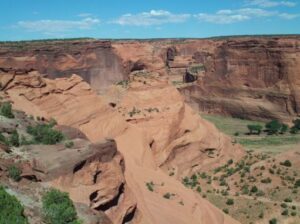
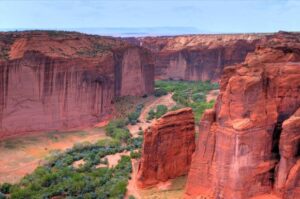 Arizona…home of the Grand Canyon and Monument Valley, is famous for its red dirt and colorful formations, but these places aren’t the only famous places in the area. In fact, the Canyon de Chelly National Monument, which is located in Apache County, Arizona, and is in the current day Navajo Nation, is one of the most visited national monuments in the United States. The strange thing is that there are many people who have never heard of it…me included, and I have been to the Four Corners region. I guess that at the time my family went there, the Four Corners (the spot where four states meet) was more interesting to us. Or maybe it was that we were headed to the Grand Canyon. Anyway, I had not heard of the Canyon de Chelly. My older sister, Cheryl Masterson might find that amusing, and might even tell me that we have been there, but for some reason, if we have been there, I don’t recall.
Arizona…home of the Grand Canyon and Monument Valley, is famous for its red dirt and colorful formations, but these places aren’t the only famous places in the area. In fact, the Canyon de Chelly National Monument, which is located in Apache County, Arizona, and is in the current day Navajo Nation, is one of the most visited national monuments in the United States. The strange thing is that there are many people who have never heard of it…me included, and I have been to the Four Corners region. I guess that at the time my family went there, the Four Corners (the spot where four states meet) was more interesting to us. Or maybe it was that we were headed to the Grand Canyon. Anyway, I had not heard of the Canyon de Chelly. My older sister, Cheryl Masterson might find that amusing, and might even tell me that we have been there, but for some reason, if we have been there, I don’t recall.
The name, Canyon de Chelly is an unusual name for the United States, even in the Southwest. It sounds a bit French, but in reality, it is universal Spanish. “Chelly” is actually derived from the Navajo word tseg, which means “rock canyon” or “in a canyon.” Spanish explorers and government officials began to utilize a “Chelly,” “Chegui,” and even “Chelle” in order to try to replicate the Navajo word in the early 1800s. Eventually, the name was standardized to “de Chelly” by the middle of the 19th century. It is thought that the canyons of de Chelly contain the artifacts and homes of Native Americans as far back as 5,000 years. At first, they lived in caves and the only real evidence of their existence is the hieroglyphics etched into the red rock walls. These people were more nomadic, and so only visited the canyons while on hunting expeditions.
Later the people who lived there were more established, and so began the period of time when the adobe structures were formed. I think that anyone who has seen adobe home, in pictures or in person would have to admit that they are very interesting. It seems so amazing to me that these people could not only make a structure that could withstand the elements as well as these structures have, but to build them on the face of the cliffs is even more amazing. Adobe, of course, is a type of construction material made from a mixture of mud, straw, and water. It is commonly used in hot, dry climates, such as in the southwestern United States. Like any home, renovation took place over the years, strengthening and changing the structures. The structures have names such as Standing Cow (named for the hieroglyphic white bull on the wall above the home), white house (so named because of a white wall in the back of the structure), Mummy Cave (I don’t believe any mummies were found there, so I’m not sure how it got its name), and Antelope House (named for the hieroglyphic carvings of antelope above it). The homes in Canyon de Chelly were abandoned around 1300, although no one really knows why. Over the past century, archaeologists, historians, and scientists have tried to pinpoint the root causes of the massive abandonment of settlements like Hovenweep, Chaco Canyon, and Mesa Verde, but there is no single consensus among experts. It might have been due to warfare, severe drought, food shortages, infectious diseases, or the emergence of new religious and cultural centers. Whatever the 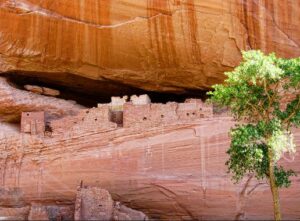
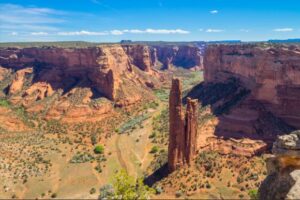 reasons, Canyon de Chelly’s people left the area and migrated south toward the more fertile Rio Grande Valley in present-day New Mexico or toward the Little Colorado River Basin in what is present-day Arizona. That is known because of the homes built in the same fashion in the Pueblos of New Mexico, the Zuni, and the Hopi Indian areas, where the structures still have the rich traditions in artistic and architectural design.
reasons, Canyon de Chelly’s people left the area and migrated south toward the more fertile Rio Grande Valley in present-day New Mexico or toward the Little Colorado River Basin in what is present-day Arizona. That is known because of the homes built in the same fashion in the Pueblos of New Mexico, the Zuni, and the Hopi Indian areas, where the structures still have the rich traditions in artistic and architectural design.
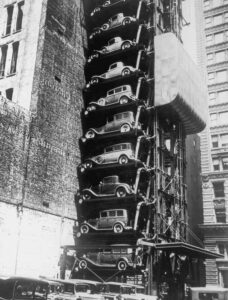 In 1932 Chicago was a city that was on the cutting edge of things, including car ownership. It wasn’t that everyone owned a car, but enough people did that there was beginning to be congestion problem where parking is concerned. It was especially bad for apartment buildings in the city. the people owned a car, but now they had to park so far away that they might as well not own a car. If they weren’t the first one home, they didn’t get to park close.
In 1932 Chicago was a city that was on the cutting edge of things, including car ownership. It wasn’t that everyone owned a car, but enough people did that there was beginning to be congestion problem where parking is concerned. It was especially bad for apartment buildings in the city. the people owned a car, but now they had to park so far away that they might as well not own a car. If they weren’t the first one home, they didn’t get to park close.
Enter the Car Parking Machine. Built by Westinghouse Electric and Manufacturing Company, the system took up the space of six cars at its base, but it held 48 cars. There are numerous compartments in the machine, and they are moving constantly in a vertical direction, like a car elevator. The system was run by an attendant, and when 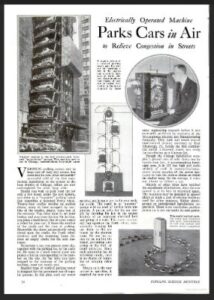 they put a car in a slot, the machine moved it to the next open slot. When the car owner wanted his car back, the attendant rotated the structure until the right car was down, and then backed the car out for the owner, just to be safe.
they put a car in a slot, the machine moved it to the next open slot. When the car owner wanted his car back, the attendant rotated the structure until the right car was down, and then backed the car out for the owner, just to be safe.
The system was such a new phenomenon that they even came out with a short film about it called ‘Vertical Auto Park Solves Problem of Windy City.’ The film shows cars being driven in cages on conveyors that rise in a Ferris Wheel like manner. People look on as cars are carried by a 105-foot-high elevator that parks 48 cars in an area of 16 by 24 feet. It was filmed on location in Chicago, Illinois and aired on April 25, 1932. The Vertical Automatic Parking Lot was actually first tested in East Pittsburgh, Pennsylvania  before being set up as a commercial enterprise in the Chicago Loop during 1932.
before being set up as a commercial enterprise in the Chicago Loop during 1932.
While the system is really quite old, it isn’t necessarily out of date. For example, look at the latest way to buy a car…Carvana. While the purpose of the elevator system is different, the idea is still the same. You find your car online, and then you can go to the car vending machine to get your car. Just like the old system, your car takes a ride in the elevator to get to you. When you think about it, the system was a good one, and should probably be used in more places. Parking congestion is an ongoing problem, after all.
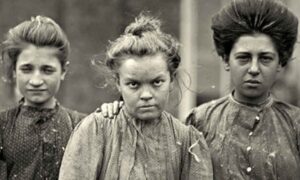 In the toughest of times, the women of the west had to participate in the work force since families had to make ends meet any way they could. But the work was demanding, often outdoors and with physical labor and lots of hours doing agricultural and other large-scale jobs. By the end of the day, they were exhausted…just like their men. It’s not that women aren’t capable of hard work, because they absolutely are. Nevertheless, their bodies aren’t built for the same kind of work as the men…or at least it isn’t as easy as for the men.
In the toughest of times, the women of the west had to participate in the work force since families had to make ends meet any way they could. But the work was demanding, often outdoors and with physical labor and lots of hours doing agricultural and other large-scale jobs. By the end of the day, they were exhausted…just like their men. It’s not that women aren’t capable of hard work, because they absolutely are. Nevertheless, their bodies aren’t built for the same kind of work as the men…or at least it isn’t as easy as for the men.
During World War I and World War II, when so many men were called to duty, and so many were killed, the workforce at home was dramatically shrinking. So, like they always did, the women stepped up. It’s not that the men weren’t stepping up too, 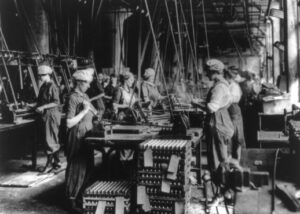 because going to war is most certainly stepping up. Really, everyone was doing a job that was not in their normal wheelhouse. Times were tough and tough times called for tough people. It the war was going to be won, the military had to be supplied with the necessary materials to fight with. Things like ammunition, uniforms, boots, tanks, planes, bombs, guns, and much more were vital; and without the help of the women back home, the men would not have the things they needed to win the war.
because going to war is most certainly stepping up. Really, everyone was doing a job that was not in their normal wheelhouse. Times were tough and tough times called for tough people. It the war was going to be won, the military had to be supplied with the necessary materials to fight with. Things like ammunition, uniforms, boots, tanks, planes, bombs, guns, and much more were vital; and without the help of the women back home, the men would not have the things they needed to win the war.
The thing about these particular women was that at that time in history, most women were stay-at-home moms, and at that time that really meant cleaning the house, cooking, and caring for the children. These were not times of going to the gym to work out, and the main exercise was the daily chores. Don’t get me wrong, because the chores  were hard work, and that did keep the women in shape, but they weren’t miners or factory workers. This necessary work was all new to them. The endeavor to bring these women into the workforce was no small undertaking. The had to be trained and trained quickly. There was no time to waste. The women, for their part, jumped at the chance to help their men and the men of the nation. They learned their new jobs quickly and did their jobs efficiently. They were loyal to their men and their country, and they were willing to take on the exhausting jobs they were asked to take on. In fact, I don’t think the wars could have been won, without both parts…the men and the women, and the necessary work they did.
were hard work, and that did keep the women in shape, but they weren’t miners or factory workers. This necessary work was all new to them. The endeavor to bring these women into the workforce was no small undertaking. The had to be trained and trained quickly. There was no time to waste. The women, for their part, jumped at the chance to help their men and the men of the nation. They learned their new jobs quickly and did their jobs efficiently. They were loyal to their men and their country, and they were willing to take on the exhausting jobs they were asked to take on. In fact, I don’t think the wars could have been won, without both parts…the men and the women, and the necessary work they did.

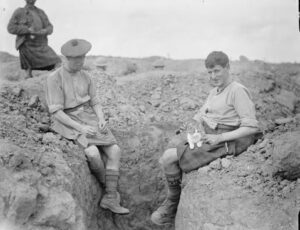 Trench warfare is a type of land warfare using occupied lines largely comprising military trenches, in which troops are well-protected from the enemy’s small arms fire and are substantially sheltered from artillery. That doesn’t protect them from many other weapons, like tanks, bomber planes, and some things that seem far more benign…rats and disease, not that these things aren’t dangerous. In fact, during World War I, these seemingly benign pests were becoming a deadly problem. Trench foot was one of the biggest disease problems, due to the wet and dirty conditions the men basically lived in.
Trench warfare is a type of land warfare using occupied lines largely comprising military trenches, in which troops are well-protected from the enemy’s small arms fire and are substantially sheltered from artillery. That doesn’t protect them from many other weapons, like tanks, bomber planes, and some things that seem far more benign…rats and disease, not that these things aren’t dangerous. In fact, during World War I, these seemingly benign pests were becoming a deadly problem. Trench foot was one of the biggest disease problems, due to the wet and dirty conditions the men basically lived in.
The rats…well, they were a bigger problem. The fact that the men “lived” in the trenches meant things like human waste, food scraps, and dead bodies drew the rats, and rats spread disease like typhus and the plague, 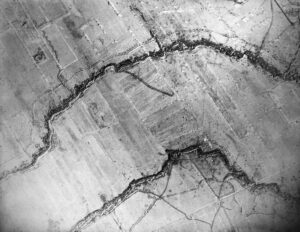 which made the problem of disease more deadly. Since trash disposal wasn’t easy in the trenches, the men often threw empty food tins out of the trenches at night. Then, the rats could be heard turning the tins over and licking the last tidbits out of them. For me the whole scene would be enough to make me want to run screaming from the scene, but that could get a soldier killed. Something had to be done…and done quickly. Due to the plentiful amount of food, some of these rats grew quite large in size. One story tells of a soldier who spotted one the size of a cat.
which made the problem of disease more deadly. Since trash disposal wasn’t easy in the trenches, the men often threw empty food tins out of the trenches at night. Then, the rats could be heard turning the tins over and licking the last tidbits out of them. For me the whole scene would be enough to make me want to run screaming from the scene, but that could get a soldier killed. Something had to be done…and done quickly. Due to the plentiful amount of food, some of these rats grew quite large in size. One story tells of a soldier who spotted one the size of a cat.
Something had to be done, so French troops tried to control the rat problem by bringing terrier dogs into the trenches with them. The plan was to let the dogs catch and kill rats, and it quickly became an interesting way to pass the time during daylight hours. Because of the dangers presented by the rats, the military actually offered soldiers a reward for killing the rats as incentive to decrease their numbers. It was a great idea, but not really practical, because rats are notoriously great escape artists…at least from humans. Nevertheless, apparently the troops got so into the 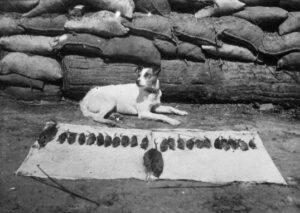
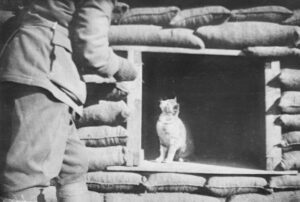 game, with one army corps managed to catch 8,000 in a single night. Other soldiers adopted cats instead of dogs, and it’s believed around 500,000 cats helped out in the trenches over the course of World War I. Many of the cats, and some of the dogs, ended up serving as mascots for troops on the front lines as well as hunters. I guess the plan worked, but maybe the animals should have been given a medal too.
game, with one army corps managed to catch 8,000 in a single night. Other soldiers adopted cats instead of dogs, and it’s believed around 500,000 cats helped out in the trenches over the course of World War I. Many of the cats, and some of the dogs, ended up serving as mascots for troops on the front lines as well as hunters. I guess the plan worked, but maybe the animals should have been given a medal too.

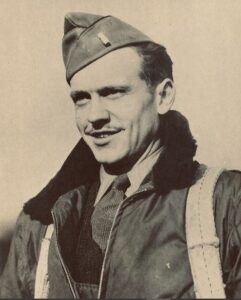 Because my dad, Allen Spencer was the flight engineer and top turret gunner on a B-17G in World War II, the B-17 has always held my interest. The plane was practically indestructible because of its great flying characteristics, resistance to combat damage, and fierce defensive firepower. Built by Boeing, it was called the B-17 Flying Fortress and it was the backbone of the American bomber force in Europe. In the European Theater of World War II (1939-1945), “one of the most dangerous occupations for Allied soldiers, sailors, or airmen was the flying of strategic bombers.” That was a statement that surprised me a little, because I would have expected the men on the ground to be in far more danger. I knew that there was a time my dad had to hang out of the open bomb bay doors to crank the landing gear down when they were damaged in combat, and I vaguely recall that they lost a ball turret gunner when he was wounded in battle and, while they pulled him out to render aid, they couldn’t save him.
Because my dad, Allen Spencer was the flight engineer and top turret gunner on a B-17G in World War II, the B-17 has always held my interest. The plane was practically indestructible because of its great flying characteristics, resistance to combat damage, and fierce defensive firepower. Built by Boeing, it was called the B-17 Flying Fortress and it was the backbone of the American bomber force in Europe. In the European Theater of World War II (1939-1945), “one of the most dangerous occupations for Allied soldiers, sailors, or airmen was the flying of strategic bombers.” That was a statement that surprised me a little, because I would have expected the men on the ground to be in far more danger. I knew that there was a time my dad had to hang out of the open bomb bay doors to crank the landing gear down when they were damaged in combat, and I vaguely recall that they lost a ball turret gunner when he was wounded in battle and, while they pulled him out to render aid, they couldn’t save him.
What I didn’t know about was something that happened on January 1, 1945, that was so bizarre that it seems like a ‘tall tale’ more than an actual event. Nevertheless, it was an actual event, and it was shocking. On that day, the Flying Fortress and the men who flew them were going to be tested beyond any limits they could have imagined, and beyond anything they were trained for. During a chaotic battle complete with ferocious anti-aircraft gunfire (flak) and enemy fighters, two B-17 Bombers managed to collide. A B-17, number 43-338457, piloted by 1st Lieutenant William G MacNab and 2nd Lieutenant Nelson B Vaughn, had risen upward. The top turret guns on MacNab’s plane had pierced through the aluminum skin on the bottom of 1st Lieutenant Glenn H Rojohn’s B-17, number 42-231987, binding the two huge planes together, as Rojohn’s co-pilot 2nd Lieutenant William G Leek, Jr said, like ‘breeding dragonflies.’ The two planes had become one. Upon impact, instead of exploding or breaking into pieces, the colliding planes became stuck together in a piggyback fashion, one atop the other. I’m sure that the men in the top plane, at least were in shock at this strange turn of affairs. I say the top plane, because it is thought that the men in the bottom plane were incapacitated or dead. There was no communication with them. Once the men realized that they weren’t going to crash, they would have to figure out their next move.
Even more shocked than the crew of the B-17 were the German fighter pilots who suddenly saw the whole confusing, but disastrous event. People just don’t expect that a mid-air collision could result in two planes stuck together. For the German fighter pilots, however, the situation took on an even more bizarre tone, because they honestly thought that the US must have created some sort of new secret weapon!! For the men onboard, the situation was dire. I’m sure they expected the explosion to come at any moment, so some of the airmen bailed out. The pilot of the top bomber, Rojohn tried, but was unable to separate the aircraft. Strangely, he was able to control the flight of the ‘hybrid dual-bomber’ somehow, despite turning his own engines off. The lower plane’s engines were still running, because its propellers were still turning. There was no communication with the crew of the bottom plane, which is why it was assumed that they were either incapacitated or already dead.
In a valiant effort, Rojohn decided to try to land the planes, probably hoping that the other crew could be saved, and complicated by the fact that he and his co-pilot, Leek couldn’t get out anyway. At that point, he might as well do his best to save the two or more of them that he could. He coaxed the joined bombers to a relatively safe landing in Germany at Wilhemshaven. Unfortunately, the lower bomber slid out from under the top bomber upon landing and immediately exploded. While the crew of the lower bomber perished in the landing and subsequent explosion, most of the crew of Rojohn’s B-17 survived and was taken prisoner. While being held in the camps, the German interrogators, who were skeptical of the account of the incident given by 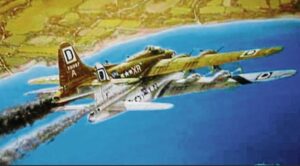
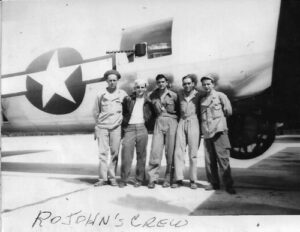 Rojohn, initially were of the opinion the flight represented a new American aerial design. I’m sure they later realized their error, but they must have also realized the resiliency of the B-17 Flying Fortress. Rojohn and his co-pilot, Leek, earned the Distinguished Flying Cross for their feat of aerial skill…a well-deserved award, if you ask me.
Rojohn, initially were of the opinion the flight represented a new American aerial design. I’m sure they later realized their error, but they must have also realized the resiliency of the B-17 Flying Fortress. Rojohn and his co-pilot, Leek, earned the Distinguished Flying Cross for their feat of aerial skill…a well-deserved award, if you ask me.

 There are a number of different kinds of governments, and people disagree on which is the best. Personally, I think that any government that takes away the freedoms of its people is destined to fail. Communism is a “political theory derived from Karl Marx, advocating class war and leading to a society in which all property is publicly owned, and each person works and is paid according to their abilities and needs.” Communism is also, known as Marxism, which is defined as “the political and economic theories of Karl Marx and Friedrich Engels, later developed by their followers to form the basis for the theory and practice of communism.” I don’t think most people know the real meaning of Marxism or Communism, or, for that matter, Socialism, which is “a political and economic theory of social organization which advocates that the means of production, distribution, and exchange should be owned or regulated by the community as a whole.” If people knew what these types of governments are really like, they would fight to keep them out of their countries. The problem is that people think the government will take care of them, and that they will benefit from the work of others. It never works that way. everyone in these situations gets poorer, except for the government.
There are a number of different kinds of governments, and people disagree on which is the best. Personally, I think that any government that takes away the freedoms of its people is destined to fail. Communism is a “political theory derived from Karl Marx, advocating class war and leading to a society in which all property is publicly owned, and each person works and is paid according to their abilities and needs.” Communism is also, known as Marxism, which is defined as “the political and economic theories of Karl Marx and Friedrich Engels, later developed by their followers to form the basis for the theory and practice of communism.” I don’t think most people know the real meaning of Marxism or Communism, or, for that matter, Socialism, which is “a political and economic theory of social organization which advocates that the means of production, distribution, and exchange should be owned or regulated by the community as a whole.” If people knew what these types of governments are really like, they would fight to keep them out of their countries. The problem is that people think the government will take care of them, and that they will benefit from the work of others. It never works that way. everyone in these situations gets poorer, except for the government.
The Union of Soviet Socialist Republics (USSR) was established in post-revolutionary Russia, on December 30, 1922. It combined Russia, Belorussia, Ukraine and the Transcaucasian Federation (which was divided in 1936 into the Georgian, Azerbaijan and Armenian republics). The new nation was also known as the Soviet Union. It was the successor to the Russian Empire and the first country in the world to be based on Marxist socialism. The rest of the world was rather stunned that this kind of regie actually existed, because it took away so many freedoms and personal property, and the people had no choice.
Because Russia was reeling from the Russian Revolution of 1917 and subsequent three-year Russian Civil War, the Bolshevik Party under Vladimir Lenin dominated the soviet forces. A coalition of workers’ and soldiers’ committees called for the establishment of a socialist state in the former Russian Empire. It was from there that the USSR was formed, and after that, all levels of government were controlled by the Communist Party, and the party’s Politburo, with its increasingly powerful general secretary, who effectively ruled the country. Everything, from Soviet industry was owned and managed by the state, and agricultural land was immediately confiscated and divided into state-run collective farms.
Over the coming decades, the Russian-dominated Soviet Union grew into one of the world’s most powerful and influential states. It eventually encompassed 15 republics…Russia, Ukraine, Georgia, Belorussia, Uzbekistan, Armenia, Azerbaijan, Kazakhstan, Kyrgyzstan, Moldova, Turkmenistan, Tajikistan, Latvia, Lithuania and Estonia. 
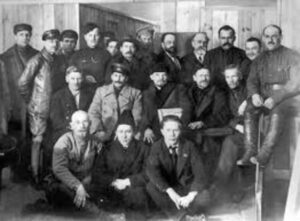 The USSR, as many knew it must, eventually failed because you can’t place people into a slave state without eventual rebellion. In 1991, the Soviet Union was dissolved following the collapse of its communist government. Communism, Marxism, and Socialism simply won’t work in the long run. If a nation wants growth and prosperity, they must have capitalism, so that the people have the incentive to be entrepreneurs, inventors, scientists, and so many other occupations in which discovery is made. Without incentive, people will simply quit.
The USSR, as many knew it must, eventually failed because you can’t place people into a slave state without eventual rebellion. In 1991, the Soviet Union was dissolved following the collapse of its communist government. Communism, Marxism, and Socialism simply won’t work in the long run. If a nation wants growth and prosperity, they must have capitalism, so that the people have the incentive to be entrepreneurs, inventors, scientists, and so many other occupations in which discovery is made. Without incentive, people will simply quit.
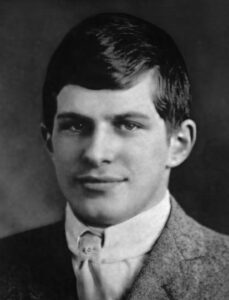
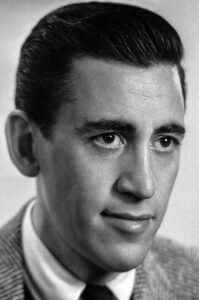 They say that genius can be the closest thing to crazy, but I don’t really know how true that is. Sometimes I think that when a person is a genius, people drive them crazy. It’s the novelty of the thing, I suppose. People find out that the genius has a super high IQ, and they all seem to want something from them. Many people don’t really care about the genius as a person, just about how they might be able to make money off of them somehow. Not every inventor is a genius, but some of them are, as are some mathematicians, doctors, teachers, writers, and many other people too.
They say that genius can be the closest thing to crazy, but I don’t really know how true that is. Sometimes I think that when a person is a genius, people drive them crazy. It’s the novelty of the thing, I suppose. People find out that the genius has a super high IQ, and they all seem to want something from them. Many people don’t really care about the genius as a person, just about how they might be able to make money off of them somehow. Not every inventor is a genius, but some of them are, as are some mathematicians, doctors, teachers, writers, and many other people too.
Sometimes the demands placed on these geniuses gets to be so heavy, that they might just snap. I don’t mean that they might go insane, although some of them have. The thing that seems to happen most, however, is that they might just decide to disappear. Several geniuses have simply vanished,  including William Sidis (who graduated from Harvard at 16, only to go into hiding, going from city to city and job to job), JD Salinger (author of Catcher in the Rye, who left Manhattan in 1953 to live on a “90-acre compound” in Cornish, NH. He remained there until his death in 2010, at age 91, saying he loved to write, but publishing was a terrible invasion of his privacy), Ettore Majorana (a theoretical physicist was considered one of the most deeply brilliant men in the world by Enrico Fermi, creator of the first nuclear reactor. One day he drained his bank account and simply vanished), David Thorne (an architect received so much attention for his work on jazz giant Dave Brubeck’s house in 1954, that he changed his professional name in the ‘60s to Beverly Thorne, got an unlisted phone number, and didn’t “resurface” until the 1980s), and Nick Gill (who at 21, was the youngest-ever British chef to win a Michelin star. He seemed destined for a life of fame and fortune and was hailed as a culinary genius. One day he told his brother he was going to disappear, and to “please, not look for him,” never to be seen again).
including William Sidis (who graduated from Harvard at 16, only to go into hiding, going from city to city and job to job), JD Salinger (author of Catcher in the Rye, who left Manhattan in 1953 to live on a “90-acre compound” in Cornish, NH. He remained there until his death in 2010, at age 91, saying he loved to write, but publishing was a terrible invasion of his privacy), Ettore Majorana (a theoretical physicist was considered one of the most deeply brilliant men in the world by Enrico Fermi, creator of the first nuclear reactor. One day he drained his bank account and simply vanished), David Thorne (an architect received so much attention for his work on jazz giant Dave Brubeck’s house in 1954, that he changed his professional name in the ‘60s to Beverly Thorne, got an unlisted phone number, and didn’t “resurface” until the 1980s), and Nick Gill (who at 21, was the youngest-ever British chef to win a Michelin star. He seemed destined for a life of fame and fortune and was hailed as a culinary genius. One day he told his brother he was going to disappear, and to “please, not look for him,” never to be seen again).
It isn’t known, as to why these geniuses would decide that they no longer wanted to be a part of the world, nor 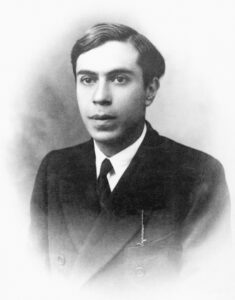
 are they to only people to do this by any means. Nevertheless, they seem to have one thing in common, their genius skill or knowledge seemed to take over their whole life, and people wouldn’t leave them alone, but rather hounded them unmercifully. I think I can understand how that would be enough to make someone want to disappear, but most people don’t actually go so far as to take that step. It is a rather extreme step to take, and for all we know some of these might have been killed or committed suicide. The sad reality for these genius minds is that the fame and constant pressure of celebrity was too much for them, and they just checked out, because the burden of knowledge was just too much for them.
are they to only people to do this by any means. Nevertheless, they seem to have one thing in common, their genius skill or knowledge seemed to take over their whole life, and people wouldn’t leave them alone, but rather hounded them unmercifully. I think I can understand how that would be enough to make someone want to disappear, but most people don’t actually go so far as to take that step. It is a rather extreme step to take, and for all we know some of these might have been killed or committed suicide. The sad reality for these genius minds is that the fame and constant pressure of celebrity was too much for them, and they just checked out, because the burden of knowledge was just too much for them.
 For thousands of years, people have wanted to feel like they left a mark on this Earth…a way to say, “I was here.” Not everyone could be famous, and in fact most people aren’t famous, nor would they want to be. Still, they want to feel like their life mattered…like someone cared that they had lived. Many of us, in fact most people are not famous. They are just everyday people who go about their daily lives…working, raising families, going to school and church, and spending time with families. Their lives would not be thought of as spectacular. Still for most people, someone…somewhere cares that they existed. Nevertheless, in 100 years it’s quite likely that no one will even remember their name.
For thousands of years, people have wanted to feel like they left a mark on this Earth…a way to say, “I was here.” Not everyone could be famous, and in fact most people aren’t famous, nor would they want to be. Still, they want to feel like their life mattered…like someone cared that they had lived. Many of us, in fact most people are not famous. They are just everyday people who go about their daily lives…working, raising families, going to school and church, and spending time with families. Their lives would not be thought of as spectacular. Still for most people, someone…somewhere cares that they existed. Nevertheless, in 100 years it’s quite likely that no one will even remember their name.
These days that may be changing with sites like Ancestry.com, My Heritage, 23 and Me, and probably others, people find it easier to be “known” by the masses. Still, many people don’t even notice if a friend lands in Facebook Jail…until they get out and tell everyone. Really most of us just live our lives…day by day, expecting everything to be normal and no real excitement. With that in mind, some people found a new way to leave a  little piece of their lives in a safe place to be found by someone else, years later. In fact, it has become a big deal…called a “Time Capsule” but it isn’t new. There was a time capsule at the high school I graduated from, and its opening years later was documented by my niece, Liz Masterson, who graduated from there too, and now is a teacher there. There was also a time capsule in a local restaurant that was found when they did some remodeling many years later. Some time capsules are even older, such as the one found in 2015 in the Cairngorms National Park in Scotland. This one was a 121-year-old time capsule, and it was discovered by construction workers on a section of the Ruthven Road bridge.
little piece of their lives in a safe place to be found by someone else, years later. In fact, it has become a big deal…called a “Time Capsule” but it isn’t new. There was a time capsule at the high school I graduated from, and its opening years later was documented by my niece, Liz Masterson, who graduated from there too, and now is a teacher there. There was also a time capsule in a local restaurant that was found when they did some remodeling many years later. Some time capsules are even older, such as the one found in 2015 in the Cairngorms National Park in Scotland. This one was a 121-year-old time capsule, and it was discovered by construction workers on a section of the Ruthven Road bridge.
Time capsules can be any kind of container. They just need to be able to stand up to the environment they are placed in. A wooden box is ok in a place that won’t get wet, and most times people try to place things in such a place. The Cairngorms National Park capsule was a metal box, similar to a safe-deposit box at a bank. The excitement around the time capsule grew, and when it was opened, the items inside that were found included…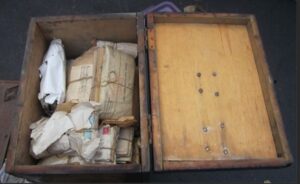 a bottle of whisky, a newspaper from 1894, a scroll, and some other items. As often happens, the items and the box itself were donated to the nearby Highland Folk Museum to be studied. As to the timeframe, it is believed that the time capsule was placed within the structure of the bridge when it was originally constructed at the end of the 19th century, so the 1894 newspaper wasn’t far off. Of course, unless there were specific names in the box, the people in the particular show of “I was here” will remain a mystery. Still, they will be remembered, even if we don’t know exactly who “they” were.
a bottle of whisky, a newspaper from 1894, a scroll, and some other items. As often happens, the items and the box itself were donated to the nearby Highland Folk Museum to be studied. As to the timeframe, it is believed that the time capsule was placed within the structure of the bridge when it was originally constructed at the end of the 19th century, so the 1894 newspaper wasn’t far off. Of course, unless there were specific names in the box, the people in the particular show of “I was here” will remain a mystery. Still, they will be remembered, even if we don’t know exactly who “they” were.

